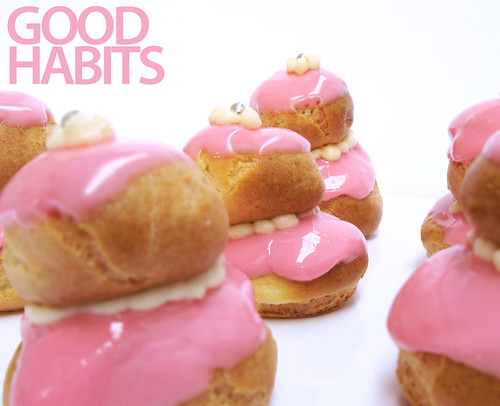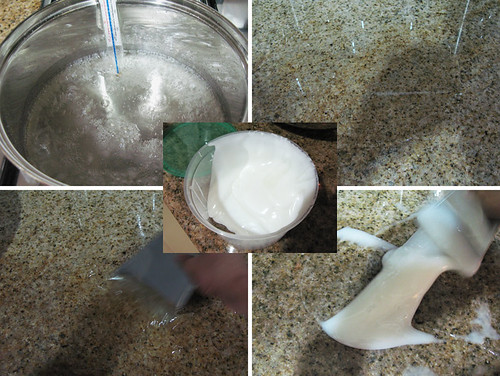Religieuses Framboises
Raspberry Religieuse
(Disclaimer! That subtitle is not meant to imply that desserts are beneficial to your health! Do exercise and eat vegetables.)
It's been a while since I've made a true pâtisserie-style dessert. I've wanted to make these relgieuses for a long time since I saw them on Cake Chef and pictures of the Ladurée. They are cream puffs with delicate fillings, stacked with eclairs and other pâté a choux shapes that somewhat resemble a nun's habit (gotta love the abstract). Mini-religieuses are composed of just two stacked cream puffs. The thing is, religieuses are topped with classic (poured) fondant (different from rolled fondant, or "sugarpaste").
Did you ever think to yourself, "There's no way this is going to work. This'll fail for sure. I don't know why I'm doing this. What am I--- OMFG IT TOTALLY WORKED HAHAHA WTF?" And you end up grinning the whole day because it totally worked and it was a lot of fun in the process. That's what making classic fondant for the first time is like. If you're wondering what the advantages to making true fondant is compared to a glaze of confectioner's sugar and water, here they are:
- It only requires plain sugar, if you don't have icing sugar on hand.
- It's smoother and is never grainy if made correctly
- The gloss is unbeatable for professional-looking desserts.

Classic Fondant (from The Simple Art of Perfect Baking by Flo Braker)
- 2-1/4 cups (1 lb or 450g) granulated sugar
- 1 cup (1/2 lb or 240g) water
- 2 tablespoons light corn syrup
Sprinkle a brushed aluminum (to prevent coloring the fondant gray) large sheet pan or smooth (marble) working surface with water.
Pour the water, corn syrup, and sugar in that order into a heavy-bottomed saucepan. Swirl the pan to moisten the sugar. Place over low heat and stir occasionally until the sugar is dissolved (5-7 minutes). When no grains are visible, stor stirring and increase the heat to medium-high. Boil until it registers 235-240°F on a candy thermometer (113-115.5°C, about 5-7 minutes-- reaches the soft ball stage: sticky and viscous like a thick pancake syrup, loses its shape when pressed). Wash down any crystals that form on the sides of the pan with a pastry brush dipped in cold water.
When the correct temperature is reached, dip the bottom of the pan immediately into cold water and pour the syrup into the marble surface or sheet pan. Wait a few minutes until it reaches 110°F (43°C) or warm to the touch.
Using a bench scraper or spatula, manipulate the outside portion of the syrup toward the center. You'll see air bubbles start to get trapped in the syrup. As it thickens and lightens, massage it back and forth, kneading with the scraper. Stop when it's smooth, creamy, and opaque. Scrape into a container, place a damp towel over the surface, and put a lid on it. Allow to ripen for 12 hours or refrigerate for up to a year.
To thin the fondant for pouring and glazing, use stock syrup:
- 5 parts water by weight to
- 8 parts sugar by weight (I used 15g water and 24g sugar, or 3-1/2 teaspoons and 5-1/2 teaspoons respectively)
Place the sugar and water in a heavy-bottomed saucepan over medium heat until it boils: by this time all the sugar crystals have dissolved.
Place a bowl over a larger bowl filled with hot tap water (140°F or 60°C). Place your fondant in the smaller bowl and work with a rubber spatula constantly but gently until melted. Add your desired coloring and flavoring-- here I used 3 drops red food color. Take as much stock syrup and mix it into the fondant gradually to produce a thin glaze. All in all I used about 2 tablespoons stock syrup.
Pâté a Choux
Use Pichet Ong's recipe as I posted here. The difference is, you should pipe out 1-inch (top) and 2-inch (bottom) spheres. Use a wet finger to smooth out any tips sticking out the top before baking. You should be able to make at least 16 tops and 16 bottoms.
Raspberry Diplomat Cream (adapted from Pierre Hermé)
There are several ways you can approach this ingredient. If you have raspberry syrup for use in iced tea and milkshakes, I suggest that you use it in the milk and continue with the recipe as directed. If you have fresh raspberries, blitz them a bit and fold into the finished product. Use your imagination!
- 2 cups (500g) whole milk
- 1/2 cup (140g) frozen raspberries, at room temperature
- 6 large egg yolks
- 1/2 cup (100g) sugar
- 1/3 cup (45g) cornstarch
- 3-1/2 tablespoons (50g) unsalted butter, at room temperature
- 2 cups (500g) heavy cream, chilled
Fill a large bowl with ice cubes and water, and set a smaller bowl on top and place a fine-meshed strainer on it.
Bring the milk to a boil over medium heat or in a microwave oven. Pour in the raspberries. In another medium heavy-bottomed saucepan, whisk together the yolks, sugar, and cornstarch. Slowly drizzle in a quarter of the hot raspberry milk, whisking all the while, and pour the rest of the milk in a steady stream while still whisking. Place than pan over medium heat and whisk vigorously and without stop. Bring it to a boil and keep at a boil while still whisking for 1-2 minutes. Scrape the pastry cream through the strainer into the small bowl. You can push the raspberry bits through the seive if desired. Cool the pastry cream to 140°F (60°C), and stir in the butter. Set aside until completely cool.
In another bowl, whip the cream until firm peaks form. Take a third of the cream and mix it into the raspberry pastry cream, then fold the lightened pastry cream into the whipped cream until well-combined.
Milk Buttercream (from Flo Braker)
Follow the recipe as I posted before here. You'll have a lot of leftovers. Actually, I used leftover frozen buttercream to make the religieuses. I just whipped it really well once thawed.
Assembly
Load the diplomat cream into a large pastry bag fitted with a quarter-inch plain tip or slightly bigger. Poke a hole through the bottoms of the choux pastry (if you haven't already through the drying process) and fill all of them with the diplomat cream. Dip the top halves of all the choux pastry into the fondant and set aside. Load the milk buttercream into a small pastry bag fitted with a 1/8" plain tip or slightly bigger. On the 2-inch choux pastry spheres, pipe a circle about 3/4" in diameter of buttercream pearls. Set the 1-inch choux pastry spheres on top (using buttercream if the fondant has set too much to allow them to stick). Pipe pearls of buttercream on top of the 1-inch choux pastry spheres and set a nontoxic silver dragée on top of each.















































